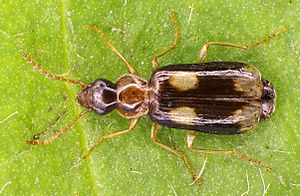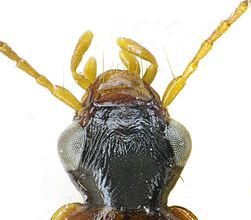Quadruped cortex
| Quadruped cortex | ||||||||||||
|---|---|---|---|---|---|---|---|---|---|---|---|---|

Quadruped cortex |
||||||||||||
| Systematics | ||||||||||||
|
||||||||||||
| Scientific name | ||||||||||||
| Dromius quadrimaculatus | ||||||||||||
| ( Linnaeus , 1758) |

|
|
| Fig. 1 (above): pronotum | |
| Fig. 2 (right): head |
The Vierfleckiger Rennläufer , also Vierfleckiger Rennläufer or Vierfleckiger Rennkäfer , ( Dromius quadrimaculatus ) is a beetle from the family of ground beetles .
The scientific name of the genus Dromius from Altgr. δρομεύς "dromius" means "runner". The genus Dromius is represented in Europe with fourteen species . The species name quadrimaculatus ( Latin "quádri-" from "quattuor": four, and "maculātus": spotted) names the four spots on the elytra. However, there are several similar four-spot species.
Characteristics of the beetle
The flat, relatively soft beetle is brightly colored and about five to six millimeters long. Legs and antennae are yellow, the pronotum and the front part of the head red-brown, the rest of the head and the wing-coverts black-brown, two spots on each wing-cover are yellowish white.
The rounded head (Fig. 2) is about as long as it is wide and slightly narrower than the pronotum. The forehead is heavily wrinkled across, only a few longitudinal wrinkles are found next to the eyes. The eleven-limbed filiform antennae are clearly very finely haired (pubescent) from the fourth limb, before that the hair is sparse. Two bristle hairs (supraorbital bristles) emerge from each of the protruding eyes . The neck is not constricted abruptly.
The reddish pronotum (Fig. 1) is laterally, especially behind the middle, set off in a broad, channel-like manner. It is slightly shorter than the head and significantly narrower than the two elytra together. Its base is slightly curved outwards and slightly narrower than the front edge. It reaches its greatest width after the first quarter. There is a bristle point near each side, and another bristle point is in the back corners.
The black-brown wing-coverts are roughly rectangular with strongly rounded outer corners. They widen only slightly towards the rear, are trimmed at the rear and leave the last part of the abdomen uncovered. They are streaked with longitudinal rows of points and have pore points in the sixth interval, but not in the third interval . There are two spots on each wing cover. The transverse oval posterior spot (apical blemish) usually also reaches the suture of the wing cover, the entire posterior margin and the posterior lateral edge of the wing cover. The line of contact with the wing cover seam is shorter than the section on the outer edge of the wing cover belonging to the flaw. As an exception, the apical blemish can flow together with the anterior blemish (disk blemish). The disc flaw is usually longitudinally oval and about the same distance from the wing cover seam and the lateral wing cover edge, the distance between the flaws and the base of the wing covers is greater.
The slender legs are yellow. The stretched tarsi are five-part. The fourth tarsal link is not lobed, the claws are toothed. Outside spikes at the end of the front rails are missing.
biology
Larvae and adults are known to be predatory. However, only very few observations have been made of the larvae, and the species can hardly be distinguished from related species in the larval stage. Both adults and larvae are observed almost exclusively on the bark of tree trunks of living trees. In surveys with several methods within forest areas, no or only a few individuals were detected in soil traps , although the species was common in the area, so they are apparently almost never to be found actively running on the soil surface. On the other hand, there are numerous observations in flight or evidence from window traps. The species is nocturnal and can be observed directly at night when the trunk surface is illuminated. The species overwinters as an imago. Reproduction occurs in spring. Adult beetles can be observed all year round, they are also active in winter in frost-free periods. During the day and in periods of frost it crawls into crevices in the bark. They also assume artificial hiding places here, provided that these offer crevices or cracks. The species occurs in forests as well as on solitary trees, on avenues and rows of trees.
The species clearly prefers deciduous trees over conifers and is one of the most common species of the genus on hardwood bark. However, there have been isolated observations of conifers, especially pines, where the species is much rarer than some relatives. Evidence is often found primarily on oak species, as well as ash and plane trees. Most of the evidence is available from the base of the trunk or from the lower trunk region, but this is essentially due to the method (accessibility). When oak crowns were misted with insecticides, the species was found very often in the crown area, but preferred the areas near the trunk in an English study. In an alluvial forest near Leipzig , the species was often detected in the canopy of the trees in window traps at a height of twenty to twenty-six meters.
distribution
The distribution area extends over almost all of Europe and continues to Asia. In Europe, reports are only missing from Portugal , Romania , Croatia , Albania and European Turkey . Individual distribution maps can be found under the web links.
literature
- Heinz Joy, Karl Wilhelm Harde, Gustav Adolf Lohse: The beetles of Central Europe . tape 2 . Adephaga 1. Elsevier, Spektrum, Akad. Verl., Munich 1976, ISBN 3-87263-025-3 .
- Ekkehard Wachmann , Ralph Platen, Dieter Barndt: Ground beetles - observation, way of life . 1st edition. Naturbuch-Verlag, Augsburg 1995, ISBN 3-89440-125-7 .
Individual evidence
- ↑ a b Dromius quadrimaculatus in Fauna Europaea. Retrieved August 31, 2012
- ↑ Sigmund Schenkling: Explanation of the scientific beetle names (genera)
- ↑ Dromius (subgenus) in Fauna Europaea. Retrieved August 31, 2012
- ↑ Sigmund Schenkling: Explanation of the scientific beetle names (species)
- ^ Bernhard Klausnitzer (1991): The larvae of the beetles of Central Europe . Volume 1: Adephaga . Goecke & Evers Verlag (Krefeld)
- ↑ a b Ron Felix & Paul van Wielink: On the biology of Calodromius bifasciatus and related species in “De Kaaistoep” (Coleoptera, Carabidae) Entomological reports 68 (6) 2008 pp. 198-209 as PDF
- ↑ Karsten Hannig, Klaas Reissmann & Axel Schwerk (2006): On the distribution, phenology and temperature preference of Calodromius bifasciatus (Dejean, 1825) in North Rhine-Westphalia (Coleoptera: Carabidae) . Entomological Journal Stuttgart 116 (4): 171-178.
- ↑ Ulrich Simon (2001): Vertical distribution and seasonality of species of the Dromius group on Scots pines . Applied Carabidology, Supplement 2: 117-122.
- ^ A b E. Arndt, S. Hielscher: Ground beetles (Coleoptera: Carabidae) in the Forest Canopy: species composition, seasonality and year-to-year fluctuation In: Unterseher, M., Morawetz, W., Klotz, S. & Arndt, E. (2007): The Canopy of a temperate floodplain forest - Results from five years of research an the Leipzig Canopy Crane . University of Leipzig, Helmholtz Center for Environmental Research UFZ, City of Leipzig. as PDF ( page no longer available , search in web archives ) Info: The link was automatically marked as defective. Please check the link according to the instructions and then remove this notice.
- ↑ J.Noordijk, Matty Berg: De corticole Fauna van Platanen: II Springstaarten, stofluizen, loopkevers (Colemboda, Psocoptera, Carabidae) Nederlandse Faunistische Mededelingen 17-2002 as PDF
- ↑ Andreas Floren & Jürgen Schmidl (1999): Faunistic-ecological results of a treetop fogging project in a high oak forest of the Steigerwald . Contributions to Bavarian Entomofaunistics 3: 179-195.
- ↑ NE Stork, PM Hsammond, BL Russell, WL Hadwen (2001): The spatial distribution of beetles within the canopies of oak trees in Richmond Park, UK Ecological Entomology (2001) 26, 302-311.
